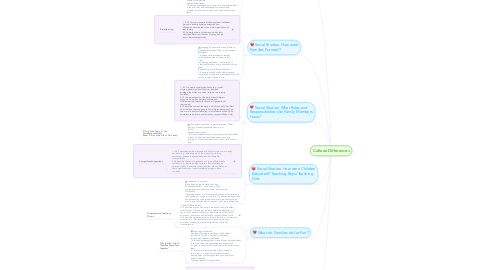Cultural Differences
by Amanda Mandaliti


1. Social Studies Ch 9: Introduction to Family Life
1.1. Overall Expectations: A1. Compare key aspects of life in a few early societies, each from a different region and era and representing a different culture, and describe some key similarities and differences between these early societies and present-day Canadian society A2. Use the social studies inquiry process to investigate ways of life and relationships with the environment in two of more early societies, with an emphasis on aspects of the interrelationship between the environment and life in those societies A3. Demonstrate an understanding of key aspects of a few early societies, each from a different region and era and representing a different culture, with reference to their political and social organization, daily life, and relationships with the environment and with each other
1.1.1. KWL Chart
1.2. Language Connection: Read-Aloud ("Squanto: Friend of the Pilgrims") - Brings together the culture of two people Specific Expectation: 1.6 Extend understanding of texts by connecting the ideas in them to their own knowledge, experience, and insights, to other familiar texts, and to the world around them
2. Social Studies: How were Families Formed?
2.1. A1.2 Compare aspects of the daily lives of different groups in an early society and explain how differences were related to the social organization of that society A1.3 describe some of the ways in which their daily life differs from the lives of young people from different backgrounds
2.1.1. Brainstorming
2.2. Language Connection: News Article on Arranged Marriages "What is an Arranged Marriage?" 1.6 extend understanding of texts by connecting the ideas in them to their own knowledge, experience, and insights, to other familiar texts, and to the world around them Responding to and Evaluating Texts 1.8 express opinions about the ideas and information in texts and cite evidence from the text to support their opinions
3. Social Studies: What Roles and Responsibilities did Family Members Have?
3.1. A1.1 compare social organization (e.g., social classes, general political structure, inherited privilege, the status of women) in two or more early societies A1.2 compare aspects of the daily lives of different groups in an early society and explain how differences were related to the social organization of that society A1.3 describe some of the ways in which their daily life differs from the lives of young people from different backgrounds in two or more early societies (e.g., with reference to family life, education, leisure time and recreation, responsibilities, work)
3.2. Language Connection: Journal Response - What are your roles and responsibilities in your family? Specific Expectations: 1.6 Extend understanding of texts by connecting the ideas in them to their own knowledge, experience, and insights, to other familiar texts, and to the world around them
3.2.1. Fully Alive: Topic 4 - We Share Responsibilities Read: "A Day in the Life of Tim Casey"
4. Social Studies: How were Children Educated? Teaching Boys/Teaching Girls
4.1. A3.3 describe significant aspects of daily life in two or more early societies (e.g., with reference to food, housing, clothing, education, recreation, spiritual/religious life, family life, transportation) A3.8 describe the social organization of some different early societies (e.g., a slave-owning society, a feudal society, an agrarian society, a nomadic society) and the role and status of some significant social and work-related groups in these societies
4.1.1. Comprehension questions
4.2. Language Connection: Study done on the Six Nations & their Educational beliefs - Use a mind map to compare two societies from social studies to the Six Nations. Classifying Ideas 1.4 sort and classify ideas and information for their writing in a variety of ways (e.g., by underlining key words and phrases; by using graphic and print organizers such as mind maps, concept maps, timelines, jot notes, bulleted lists)
5. What do Families do for Fun?
5.1. Specific Expectations: A1.3 describe some of the ways in which their daily life differs from the lives of young people from different backgrounds in two or more early societies (e.g., with reference to family life, education, leisure time and recreation, responsibilities, work) A3.3 describe significant aspects of daily life in two or more early societies (e.g., with reference to food, housing, clothing, education, recreation, spiritual/religious life, family life, transportation)
5.1.1. Comprehension Questions T-Chart
5.2. Language Connection: Students will create a storyboard of what their families do for fun - using real or illustrated images with captions underneath 1.6 extend understanding of texts by connecting the ideas in them to their own knowledge, experience, and insights, to other familiar texts, and to the world around them 2.1 Write more complex texts using a variety of forms (e.g., a storyboard using captions and photographs or drawings to recount a significant event in their life; *Gradual release of responsibility
5.2.1. Fully Alive: Topic 1 - "Families Spend Time Together"
